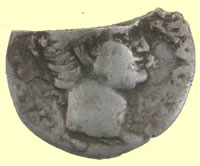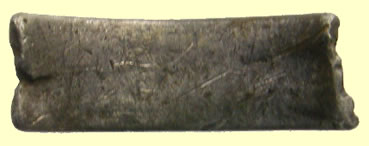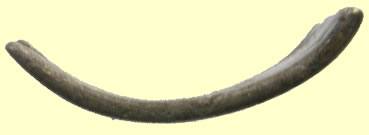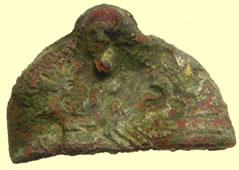

Metal detecting holidays in England with the World's most successful metal detecting club.
Twinned with Midwest Historical Research Society USA
| 2012 Feb Latest Finds Page II |
1726 George 1st milled gold full guinea
|
|||||||||||
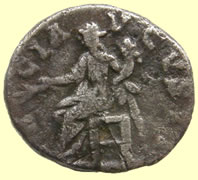  |
|||||||||||
2ndC Roman bronze coin sent for ID This is a denarius of Septimius Severus, 193-211 AD. The title in the obverse legend - L SEPT SEV PERT AVG IMP III - dates the piece to 194 AD. The reverse type - PACI AVGVSTI - shows Pax seated left holding an olive-branch and a cornucopaie. Severus was the less-famous father of the infamous emperor Caracalla. Severus died while on campaign in Britain, where he'd been strengthening defenses and rebuilding Hadrian's wall since 208, in York, on February 4, 211. His death left sons Caracalla and Geta to share the throne as co-emperors, but Caracalla's plans didn't include giving power or advantage to his younger brother on whom he had wasted no love. On the premise of a meeting of reconciliation with Geta held at a family villa soon thereafter, he had arranged for his bodyguard to attack and fatally stab Geta, who subsequently died in their mother's arms. Nice folks. Mark
|
|||||||||||
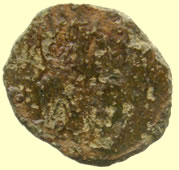 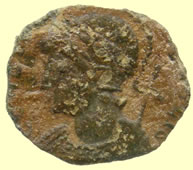 |
|||||||||||
Mid 4thC Roman bronze coin sent for ID This appears to be a CONSTANTINOPOLIS city commemorative. As the move of Constantine's seat of government to Constantinople was about to be implemented and become official in 330 AD, a very large emission of city commemoratives for both Rome and the new Capital was issued at the same time as the very common and familiar pieces with a portrait of a Constantinian family member and GLORIA EXERVITVS soldiers and standard(s) reverse. The VRBS ROMA commemoratives showed a similar armored bust of the personification of the city of Rome and had the shewolf suckling the twins Romulus & Remus on its anepigraphic reverse. Mark |
|||||||||||
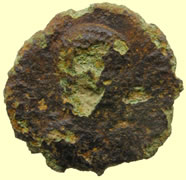 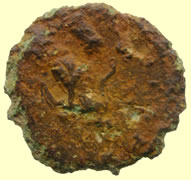 |
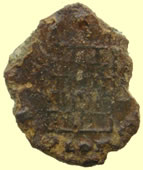  |
||||||||||
2ndC Roman bronze coin sent for ID The "sestertius" sized piece offers us less by way of positive markers, but the shape of the head (and the "corn-row" at the top of it) seems most like Julia Domna, wife of Septimius Severus. I can't figure what's happening on the reverse, but the chance that the orientation is based on whatever it is that looks like the letter "Y" is very unlikely. I'll try rotating the image a bit and see if it rings any bells. Here's an example of a sestertius of Domna, to show you what I'm talking about, re: the portrait sort of resembling her: http://www.stoa.org/gallery/Chaos-and-the/ML_10_Domna_Juno_sest
|
4thC Roman bronze coin sent for ID This is a so-called "campgate" (probably actually a signal tower) reverse. The mint mark - in exergue - is clearly London. The legend on the reverse is almost totally gone, but it appears to end "...SS" meaning it would more likely be the PROVIDENTIAE CAESS than the PROVIDENTIAE AVGG legend, of the 2 types most commonly found on these. So the greatest likelihood that it is Constantine II or Constantius II (less likely) although Crispus (I think) is also a possibility. Constantius II only got in on the tail end of the campgate period just as Crispus only made the earliest part. This dates to the 320's - mostly the later 320's, although, as I said, Crispus (d. 324) did get in on the very beginning of the type.
|
||||||||||
 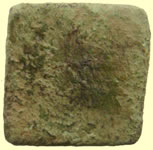 |
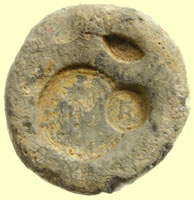 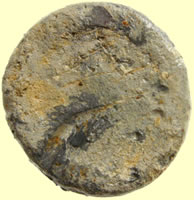 |
||||||||||
| 16thC Antwerp hand coin weight | 1680's James II lead trade weight - IR - Plumbers Company mark | ||||||||||
 |
|||||||||||
| Medieval purse bar | |||||||||||
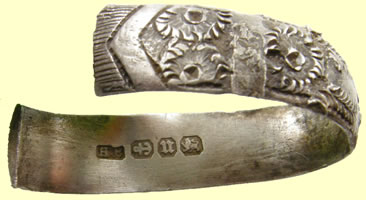 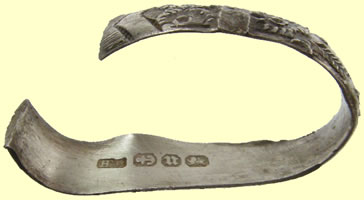 |
|||||||||||
1894 Birmingham silver ring - anchor mark , pure silver , maker H.B
|
|||||||||||
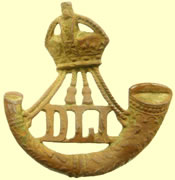 |
 |
||||||||||
| WW1 THE DURHAM LIGHT INFANTRY CAP BADGE | 16thC Tudor S buckle | ||||||||||
  |
 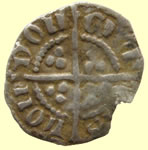 |
||||||||||
| 1500-1700 mount | 1299-1300 Edward 1st hammered silver farthing - Type 21 -reversed S Rev ER ANGL D N Obv CIVI/TAS/LON/DON - London mint |
||||||||||
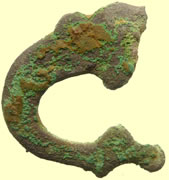 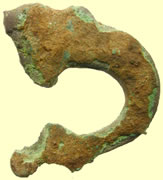 |
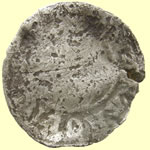 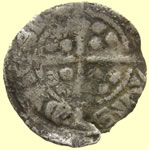 |
||||||||||
| 4th Roman buckle | 1341 Edward III hammered silver florin penny Rev CIVI/TAS/DVN/ELM -Durham mint |
||||||||||
 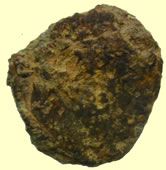 |
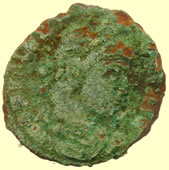  |
||||||||||
4thC Roman bronze coin sent for ID Just a W.A.G. (as we academic types say...) this might be a SALVS REIPVBLICAE reverse from the later Valentinian Dynasty era. (Valentinian II, Theodosius I, Arcadius - 383-393 AD) I can't tell which of the 4 possible emperors it might be, however. At least this seems to be the most likely reverse type - this makes this one of the latest Roman coins I can recall you finding. Mark |
4thC Roman bronze coin sent for ID This is Valentinian I - 364-375 AD - the type is SECVRITAS REIPVBLICAE with Victory walking left holding wreath and palm. This is one of the most common types from the time immediately following the Constantinian era. If you were to do a little brushing around the exergual area, we might be able to tell from the mint mark where it was struck. Mark
|
||||||||||
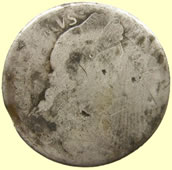  |
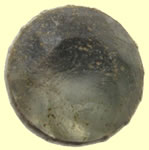 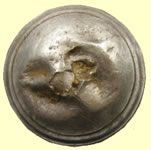 |
||||||||||
| 1696 William III milled silver shilling | 18thC silver button with glass stone | ||||||||||
 |
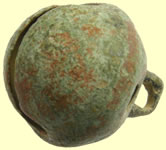 |
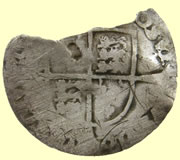 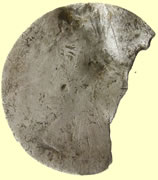 |
|||||||||
|
18thC crotal bell | 1554 Mary hammered silver groat | |||||||||
  |
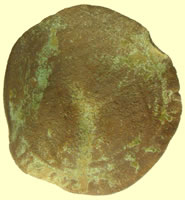  |
||||||||||
1247 Henry III hammered silver voided long cross half penny Obv HENRICVS REX Rev **ON LVND - London mint |
1603 James 1st hammered silver shilling forgery Jacobvs IIX |
||||||||||
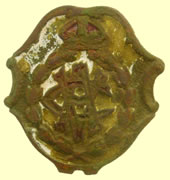 |
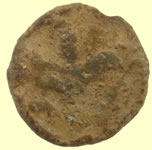 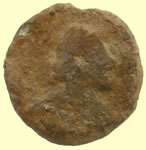 |
||||||||||
| Commando Veterans Association badge | 17thC lead token | ||||||||||
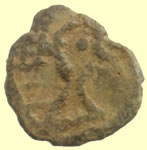 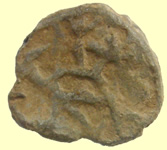 |
 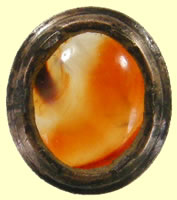 |
||||||||||
| Early medieval lead token | Georgian intaglio with gold bezel - bust facing right | ||||||||||
  |
 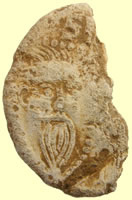 |
||||||||||
| 1199 John hammered silver short cross half penny - Class 5b | 13thC lead papal badge | ||||||||||
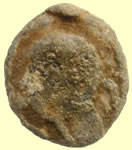 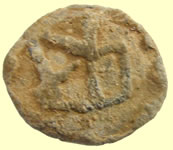 |
  |
||||||||||
| Roman lead token | 1859 Victoria milled silver shilling ( 12 pence) | ||||||||||
  |
|||||||||||
BC Roman silver coin - sent for ID Surprisingly, there is just enough left visble in just the correct places to allow me to place this as an issue of L. Julius Bursio, 85 BC. Sear says: Mark |
|||||||||||
 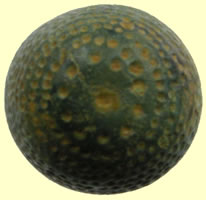 |
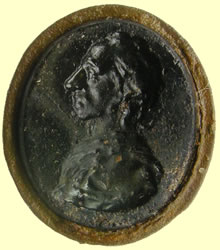 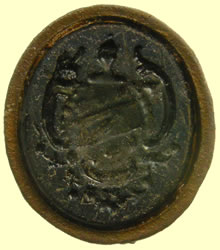 |
||||||||||
| Medieval beehive thimble | Georgian fob seal | ||||||||||
|
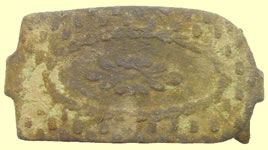 |
||||||||||
| 18thC decorated silver clog fastener - inscribed A.T | 18thC decorated clog fastener | ||||||||||
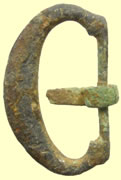 |
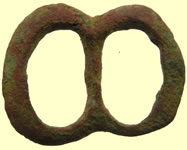 |
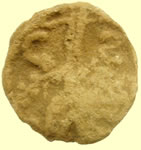 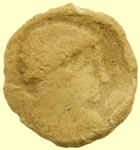 |
|||||||||
| Medieval D buckle | 1550-1650 buckle | Roman lead token | |||||||||
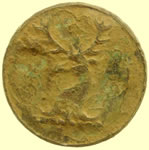 |
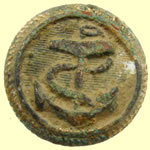 |
  |
|||||||||
| 19th C livery button | Britain's Merchant Navy Generic Design Issue In use 1900 's onwards |
Early Post-Medieval (1500-1700) copper alloy belt mount in the form of an acorn | |||||||||
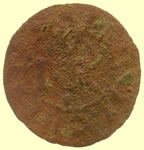 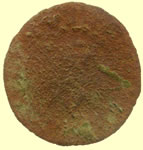 |
 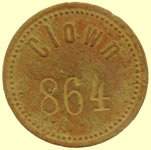 |
||||||||||
17thC Thomas Reynolds bay maker of Colchester hammered copper trade farthing |
20thC arcade token - 2D (2 old pence) | ||||||||||
 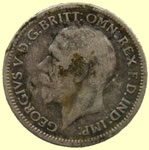 |
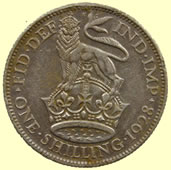 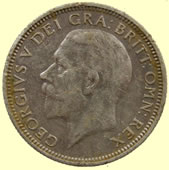 |
||||||||||
| 1928 George V milled silver sixpence | 1928 George V milled silver shilling (12 pence) | ||||||||||
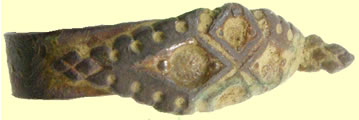 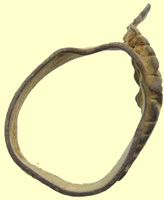 |
|||||||||||
| 17thC finger ring | |||||||||||
 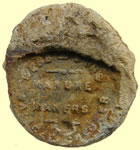 |
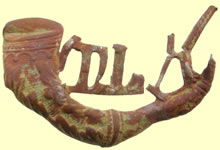 |
||||||||||
| Post medieval lead bale seal | WW1 THE DURHAM LIGHT INFANTRY CAP BADGE | ||||||||||
 |
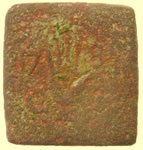 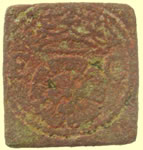 |
||||||||||
| 20thC charm | 16thC coin weight The crown of the double rose was popular coin in Europe. Many weight so this design were issued in Germany and the Low countries for both the crown issued 1526-44 48 grains Obv Crown/Rose EC Rev - This is an Antwerp hand type and dated 1578 maker Co
|
||||||||||
 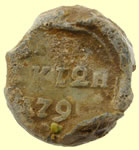 |
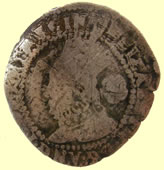  |
||||||||||
| 1790 Russian lead bale seal | 1582 Elizabeth 1st hammered silver half groat | ||||||||||
 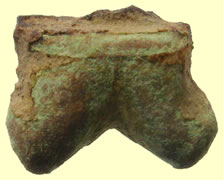 |
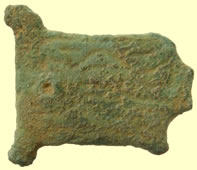 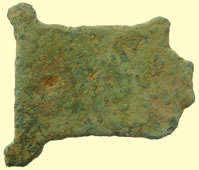 |
||||||||||
| 17thC knife pommel | Medieval decorated buckle plate | ||||||||||
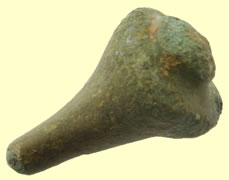 |
 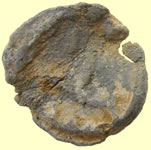 |
||||||||||
| Roman bronze mount | 17thC lead token | ||||||||||
 |
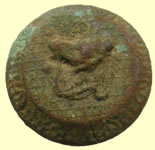 |
  |
|||||||||
| 17thC lead token | 19thC hunting button | 17thC Thomas Reynolds bay maker of Colchester hammered copper trade farthing |
|||||||||
 |
 |
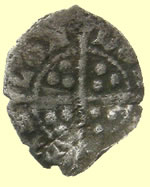  |
|||||||||
| Celtic Pokemon !! | 16thC Tudor fretwork button | 1322-7 Edward III hammered silver farthing Obv EDWARDVS REX A Rev - CIVI/TAS/LON/DON - London mint 0.25g,11.12 mm |
|||||||||
 |
|||||||||||
| Large Victorian gold fob chain - each linked is indivdually marked 0.375, 9carat gold | |||||||||||
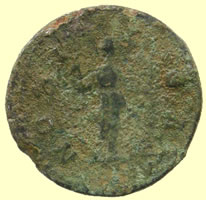 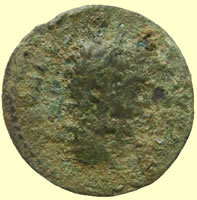 |
|||||||||||
Silver washed Roman coin sent for ID Wow - this is sort of a puzzle. I'll get back to you with with some sort of explanation after I do a little more research. As you can see, the clearest bits of legend on the coin are the letters "NO..." in the reverse legend, which seems to end "...S AV[G]" There are precious few Roman coin legends which begin with the letter "N" - NOBILITAS AVG - would be my first guess, but in a really brief search of lists of legends on the denarii of the usual suspects, I can't find a single usage of it - or any other legends beginning "NO...". I'm presuming this is approximately denarius/antoninianus size, right? "Æ3" generally speaking - somewhere between maybe 15 & 20 mm, right? Too bad it can't be cooked, but perhaps it could either be soaked - or in a worst-case scenario, perhaps some very careful electrolysis (low current for brief periods of time, watched very closely) could clean it up without killing it. The first impression I have from the seemingly curly-haired portrait is Marcus Aurelius, Verus or Commodus. If it's Æ or low-grade billon, then it would have to be a contemporary copy since the Antonine dynasty all used reasonably good-quality silver. Æ, billon or silver-wash denarii in good style and reasonably believable workmanship are often found in the Balkans - they're erroneously referred to as "Limes denarii". We don't know exactly how they fit into the monetary scheme, but so many have been found in recent years that what used to be a rare curiosity is now a common curiosity with no explanation, except that it's obvious there were many of them in circulation - That incorrect name has been used so long that I'm afraid it's going to stick no matter how inaccurate a term it might be. I'll get back to you when/if I get a better idea of what this is. Mark I have to stick with a higher probability of this being Septimius Severus on an Eastern European Æ denarius with a NOBILITAS reverse than anything else I can propose - unless you can make a case for it being silver under the crud - in which case it might well be an official denarius of the same type. You say "silvered", so I have to believe it's one of the aforementioned copies, the exact usage and place of which within the monetary system is not clearly understood - although they obviously passed current at some level. There is a small possibility of it being another of the Severans, possibly Geta Augustus, but that's pretty unlikely. Mark |
|||||||||||
  |
 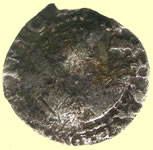 |
||||||||||
1422-61Henry VI hammered silver halfpenny - 1st reign Annulet Issue - Annulets by neck and reverse with annulets in VIL and CAL qtrs Obv +hENRIC REX ANGL Rev VIL/LA/CAL/IS - Calais mint |
1587 - 9 Elizabeth 1st hammered silver penny | ||||||||||
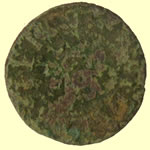 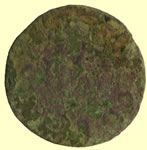 |
  |
||||||||||
| 1665 Colchester hammered copper trade farthing | 1215 Henry III hammered silver 1/4 penny | ||||||||||
  |
  |
||||||||||
| 1561-5 Elizabeth 1st hammered silver sixpence | 1341 Edward III hammered silver florin penny Obv ** ANGL DNS HYB Rev CIVI/TAS/CAN/TOR - Canterbury mint |
||||||||||
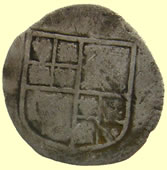  |
  |
||||||||||
| 1603 James 1st hammered silver half groat | 1422-1460 Henry VI hammered silver penny Obv VIL/LA/CAL/ISIE - Calais mint |
||||||||||
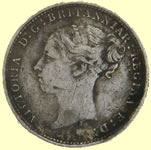  |
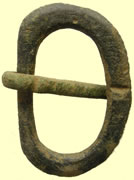 |
 |
|||||||||
| 1881 Victoria milled silver 3 pence | Medieval D buckle | Georgian button | |||||||||
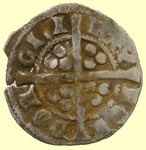 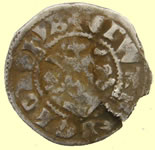 |
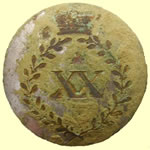 |
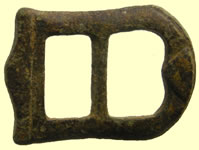 |
|||||||||
1279 Edward 1st hammered silver penny - Class 10cf Miss spelling type missing E Obv DRWARD ANGL DNS HYB Rev CIVI/TAS/LON/DON - London mint |
1820's 20th regiment of fooot officers buttons | 1550-1700 buckle | |||||||||
Royal Arch Masons Jewel Deo Regi Fratribus Honor Fidelitas Benevolentia Huge Victorian silver badge - one side is Latin and other reads Beauty, Wisdom, Truth, Concord, Strength 9.0g, 47mm H - Maker Spencer of London Deo regi fratribus honor fidelitas benevolentia" - "Every Royal Arch Mason is entitled to wear the Jewel of the Degree". |
|||||||||||
  |
  |
||||||||||
| 20th 4D - 4 old pence trade token | 1327 Edward III hammered silver half groat Rev CIVI/TAS/EBO/RACI - York mint |
||||||||||
3rdC Roman coin sent for ID 22.22mm, 3.55g Remember the "hoard" you had last year which included a dozen or so pieces from the short-lived Magnentius and his brother Decentius? - This is another of those - it even seems to have nearly identical plow-soil damage, edge chipping and surface and degradation as those displayed. It's probably Magnentius since his coins are somewhat less scarce than those of his shorter-lived brother - both were portrayed with similarly dopey facial expressions and equally dopey haircuts. The reverse shows 2 Victories holding a shield inscribed VOT / V / MVLT / X between them - the reverse legend should be VICTORIAE DD NN AVG ET CAE or very close thereto. Magnentius was Augustus in parts of the west from 350 to 353 at which time he and his brother, whom he'd made Caesar in 351, were defeated by Constantius II and committed suicide rather than being captured, imprisoned and eventually dishonorably executed by Constantius. Mark |
|||||||||||
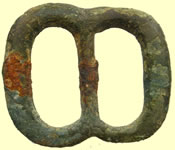 |
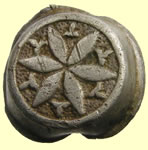 |
 |
|||||||||
| 1550-1650 buckle | 18thC silver button | Victorian silver bird charm | |||||||||
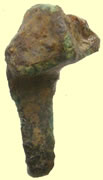 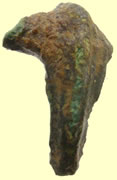 |
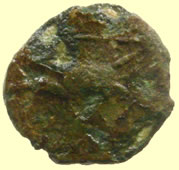 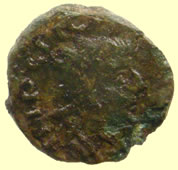 |
||||||||||
| 2ndC Roman fibular brooch | 4thC Roman coin sent for ID 13.36mm,1.41g This little guy appears to be a contemporary copy Æ radiate from the period 260-270 AD. The size is too small and the weight too low to be an offical anything. The design is a mish-mash of bits from several protoypes. The obverse legend is blundered at best - if not totally illiterate - so it's uncertain who is intended. The portrait seems not to be meant to resemble anyone in particular, although it is far less crude and cartoonish than many of these. The reverse seems to be modeled on the ADVENTVS reverses common to Tetricus and Claudius II Gothicus which show the emperor on horseback left, walking or prancing, raising right hand. This is a really unusual reverse for one of these so-called "barbarous radiates" - I don't think I've ever seen one with an equestrian reverse before - but it's an unusual day in this field that you don't learn or see somethng new. Mark |
||||||||||
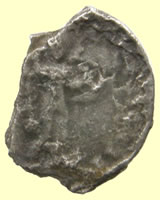  |
|||||||||||
2ndC Roman silver coin sent for ID I'm pretty sure this began life as a denarius of Domitian, 81-96 AD. Depending how complete the roman numeral at 5:30 might be (is it VI? or VII?) it could have been minted any time from 86-88 AD. More than that, there simply is not enough detail left to say with any authority. Mark
|
|||||||||||
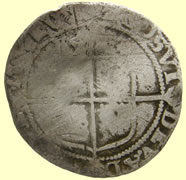 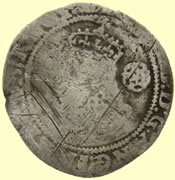 |
  |
||||||||||
| 1580 Elizabeth 1st hammered silver sixpence | Taco'd 1603 James 1st hammered silver half groat | ||||||||||
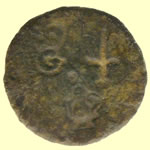 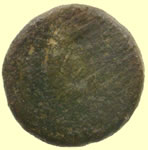 |
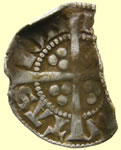 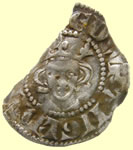 |
||||||||||
| George 1st trade weight - Crown G London cipher | 1279 Edward 1st hammered silver penny - Class 11 - angular backs to E Obv EDWR ANGLE DNS ** Rev CIVI/TAS/DON/DON - London mint |
||||||||||
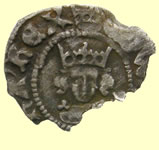 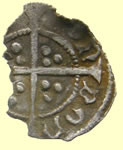 |
  |
||||||||||
1464-70 Edward IV hammered silver half penny - Light coinage - I.m Crown, satires by neck Obv EDWARD DI GRA REX Rev CIVI/TAS/LON/DON |
16thC coin weight - Low countries for rijer, Burgundian rider or ridergulden | ||||||||||
Saxon gold casting waste 59.49 g, 60.61mm wide |
|||||||||||
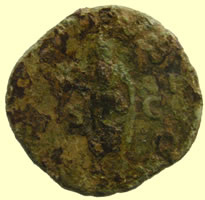  |
|||||||||||
Huge Roman bronze sent for ID 29.22mm ,13.69g Without at least a bit of revelatory legend on the obverse (the "IMP..." at 8:00 isn't much help - nearly all the emperors from the 1st through the 3rd century began their official titles with "IMP") all I have to go on is the shape of the head and the general overall "fabric" of the piece. Being somewhat square, it belongs to the period in which "cob" style flan production had replaced the sphere-cast & hammer-flattened Æ blanks flans of earlier years. The earlier type of flan manufacture had produced a more nearly round product but was more labor-intensive and slower. Generally - although it is seen on-and-off for quite a while - the latter part of the 2nd and most of the 3rd century saw this form of blank production for the large Æ in which a round bar of coin metal approximately the desired diameter of the finished coins was cast, then individual blanks were chopped off the end with 3 or 4 heavy hammer and chisel strokes, on an anvil, rotating the bar 90º at a time between strikes. This tended to make squarish flans - like the one we see here. The vague standing deity or personification on the reverse doesn't show any attributes that might allow me to say who was intended - and the emperors of this period tended to use all the possible deities and personifications over time, so even if we knew who was on the reverse, it probably wouldn't be of any help identifing which emperor struck it. So, judging by the squarish flan and the shape of the head, I'd say this is most likely to be Severus Alexander, 222-235 AD. Here is a relatively unusual example struck on a large, "medallic" flan which doesn't show the results of cob manufacture nearly as clearly as some: Mark |
|||||||||||
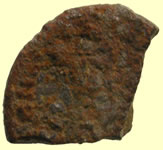 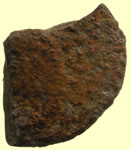 |
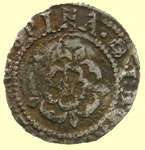 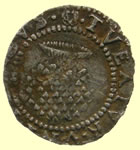 |
||||||||||
| Crispy silver Roman coin - cooking to remove crust | 1605-6 James 1st hammered silver penny | ||||||||||
 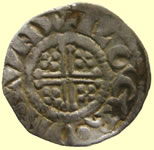 |
 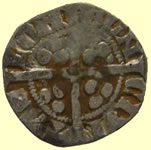 |
||||||||||
1199 John hammered silver penny - Class 5c Obv HENRICVS REX Rev ILGIER ON LVND - Moneyer Ilger of London mint |
1341 Edward III hammered silver florin penny Obv EDWAR R ANGLE DNS HYB CIVI/TAS/LON/DON - London mint |
||||||||||
 |
 |
 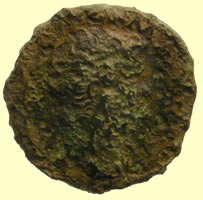 |
|||||||||
| Norfolk and Suffolk Yacht club | 18thC Royal Artillery button | 2nd C Roman bronze coin - sent for ID 26.44mm, 8.17g My best guess is that this one is probably Hadrian (117-138 AD.) going strictly by the shape of the head. However, the reverse is going to be impossible to say much more than that it portrays a deity or personification standing to the right (? I think). This is getting close to the outer edges of identifiability - by photo at any rate. Mark |
|||||||||
 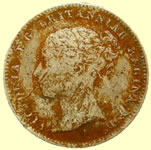 |
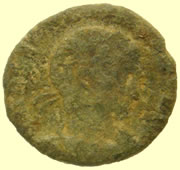  |
||||||||||
| 1842 Victoria milled silver four pence | 4thC Roman bronze sent for ID You seem to be findingt a lot of contemporary copies these days. This is almost certainly the product of an "unofficial" mint around 315-320 AD. I am a little stumped, however, as to just what sort of coin was used as a prototype for this. It seems a little like the earlier 4th century late-issue folles of the Licinii (some were struck for Constantine & family, but the Licinii are far more often represented) of the "IOVI CONSERVATORI" series. Those will have Jupiter standing left and generally holding a small figure of Victory in right hand and resting on a scepter with his left. An eagle and/or a bound captive might appear at his feet or the Victory might be replaced with a thunderbolt, etc. This is an example of a common type of IOVI CONSERVATORI piece which might have served as a prototype, but placing the scepter in the right hand on yours - although Constantine is more usually portrayed with a Sol reverse (SOLI INVICTO COMITI) during this time period http://www.stoa.org/gallery/album162/49_Constantine_I_Follis_312_13_ICA_TES This is an example of a far more commonly encountered Licinius/IOVI late follis http://www.stoa.org/gallery/album162/56_Licinius_I_Follis_315_16_ICA_HER Alternately, the prototype might have been one of the PRINCIIPIA IVVENTVTIS types of Crispus, Consatntine II and Licinius II Caesars. http://www.stoa.org/gallery/album164/09_Crispus_PI_ARL_AE It could be a "fantasy" reverse based loosely on all the various standing deity/Imperial reverses of the era and not meant to really copy any one of them. Interesting piece - I've never seen a contemporary copy of this sort - although the same era saw prolific local copying of the VICTORIAE LAETAE PRINC PERP 2 Victories pieces in the Balkans. Perhaps the conflict between the Constantinian family/party and the Licinii and their supporters interrupted Imperial coin supplies to Britain at the same time as they did in the Balkans. That's just a guess, however. Mark |
||||||||||
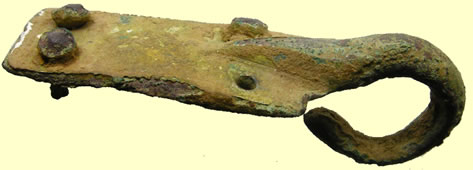 |
|||||||||||
| Huge medieval gilded hooked mount | |||||||||||
17thC silver seal matrix - rev initial IC , reported as treasure to museum |
|||||||||||
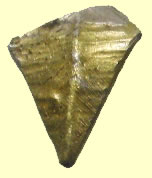 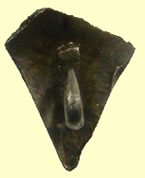 |
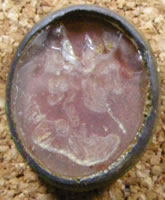 |
||||||||||
| 16thC Tudor gold on silver hooked fastener - reported as treasure to museum | Georgian intaglio | ||||||||||
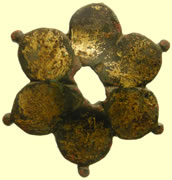 |
 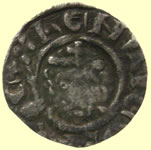 |
||||||||||
| 17thC gilded knife quillion | 1180-1189 Henry II hammered silver penny - Class Ib Rev WILLELM.ON. LV , Moneyer Willelm of London |
||||||||||
18thC decorated clog fastener
|
|||||||||||
  |
  |
||||||||||
| 1573 Elizabeth 1st hammered silver threepence | Medieval mount | ||||||||||
  |
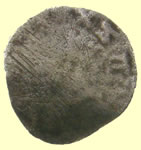 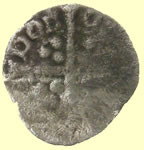 |
||||||||||
1341 Edward III hammered silver florin penny Obv EDWAR R ANGLE DNS HYB Rev CIVI/TAS/CAN/TOR - Canterbury mint |
1300-10 Edward III hammered silver farthing Obv EDWARDVS REX AN Rev CIVI/TAS/LON/DON - London mint |
||||||||||
 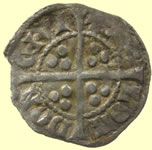 |
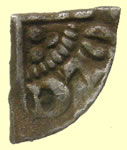 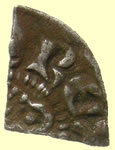 |
||||||||||
1341 Edward III hammered silver florin penny Obv EDWARDVS REX ANG Rev CIVIT/TAS/LON/DON - London mint |
1247 Henry III hammered silver voided long cross 1/4 penny Moneyer Nicole |
||||||||||
 |
 |
 |
|||||||||
| 19thC buckle | 18thC clog fastener | 1500-1700 mount | |||||||||
  |
 |
||||||||||
| Medieval mount | Medeival buckle | ||||||||||
 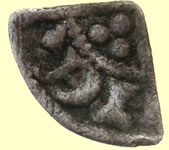 |
 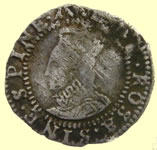 |
||||||||||
| 1247 Henry III hammered silver voided long cross 1/4 penny | 1582 - 4 Elizabeth 1st hammered silver penny | ||||||||||
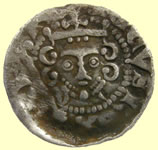  |
  |
||||||||||
1247 Henry III hammered silver voided long cross penny - Class 5b Obv HENRICVS REX Rev NIC/OLE/ONC/ANT/ Monyer Nicole of Canterbury mint |
1215 Henry III hammered short cross silver 1/2 penny | ||||||||||
 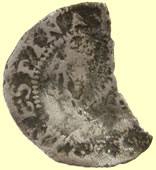 |
 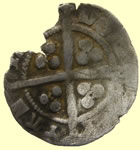 |
||||||||||
| 1552 Elizabeth 1st hammered silver half groat |
1351-61 Edward III hammered silver penny- Pre treaty - annulets in obv quadrants Obv EDWARDVS REX ANGLI Rev CIVIT/TAS/LON/DON - London mint
|
||||||||||
  |
  |
||||||||||
1199 King John hammered silver short cross half penny - Class 5b Reb + Willel ** , Moneyer Willelm |
C10thC Saxon gilded disc brooch | ||||||||||
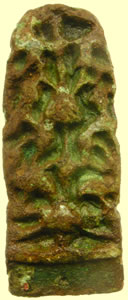 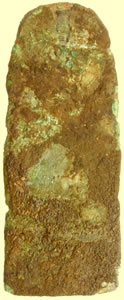 |
|||||||||||
Huge C 9thC Viking 'Ladder of life' strapend - theses are know for being unusually large 70.23mm L x 28.15mm W, 43.24g |
|||||||||||
 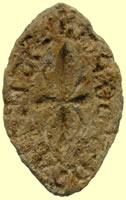 |
 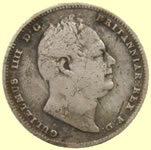 |
||||||||||
| 13thC lead vessica seal matrix | 1835 William IV milled silver sixpence | ||||||||||
 |
 |
 |
|||||||||
| 18thC Royal Navy button | 1603 James 1st trade weight | Royal Artillery cap badge | |||||||||
 |
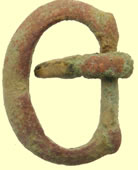 |
  |
|||||||||
| 1900's Generic merchant navy button | 1550-1650 buckle | 1341 Edward III hammered silver florin penny Obv EDWAR ANGLE DNS HYB Rev CIVIT/TAS/LON/DON - London mint |
|||||||||
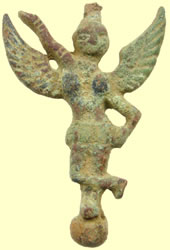 |
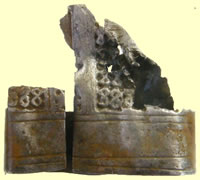 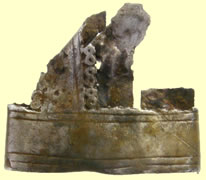 |
||||||||||
| Victorian Eastern figurine finial | 17thC - Very interesting figure of 8 design on this silver thimble Reported as Treasure - matching design in PAS NMS-653275 Treasure case tracking number: 2012T135 |
||||||||||
  |
 |
 |
|||||||||
| Roman pendant hanger mount | Georgian watch winder | 19thC button | |||||||||
 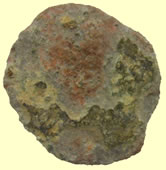 |
  |
||||||||||
| Mid 4thC Constantine Roman bronze - two soldiers standing | 1247 Henry III hammered silver qtr penny | ||||||||||
 |
  |
||||||||||
| Medieval strap end | 1279 Edward 1st hammered silver penny Durham mint |
||||||||||
 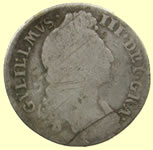 |
|
||||||||||
| 1696 William III milled silver sixpence | 16thC Tudor gold on silver ring - reported as treasure to museum | ||||||||||
 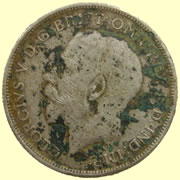 |
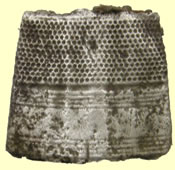 |
 |
|||||||||
| 1920 George V milled silver Florin (24 pence) | 18thC silver thimble | Georgian watch winder | |||||||||
 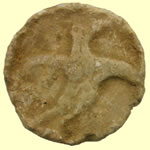 |
  |
||||||||||
| 17thC lead token | Medieval lead trade weight - cross and annulets | ||||||||||
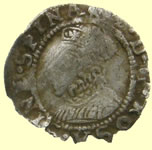  |
  |
||||||||||
| 1560-1 Elizabeth 1st hammered silver penny - Marlett mint mark | 1215 Henry III hammered silver half penny | ||||||||||
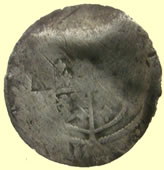 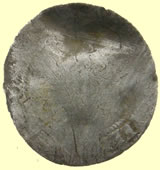 |
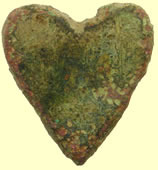 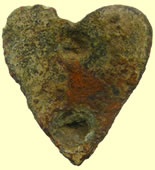 |
||||||||||
| 16thC Elizabeth 1st hammered silver half groat | 1500-1700 mount | ||||||||||
 |
  |
||||||||||
| 17thC clothing fastener | Medieval gilded mount - 2 integral lugs | ||||||||||
 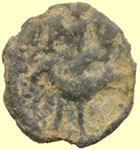 |
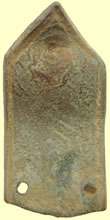 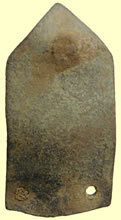 |
||||||||||
| 17thC lead token | Medieval casket mount - King on throne | ||||||||||
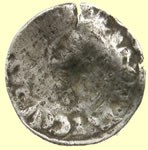  |
 |
||||||||||
1199 John hammered silver penny - Class 5b2 Obv HENRICVS REX Rev ILGEIR ON LVNDE - Moneyer Ilger of London mint |
Large shield boss with fixing wings - cannot find any parallel for Roman or Medieval | ||||||||||
 |
 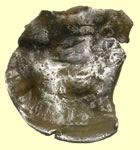 |
||||||||||
| 17thC double headed eagle hanger | 1279 Edward 1st hammered silver penny Durham mint |
||||||||||
 |
 |
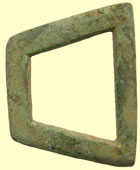 |
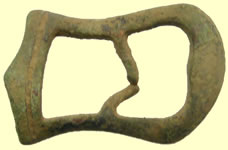 |
||||||||
| Victorian swam brooch | 17thC silvered mount | 1500-1650 buckle | 1550-1700 buckle | ||||||||
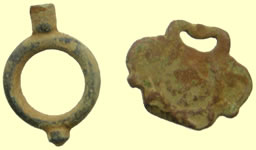 |
 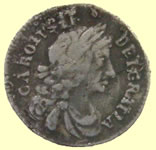 |
||||||||||
| Georgian watch winders | Tiny 1670 Charles II milled silver penny | ||||||||||
 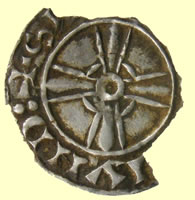 |
|||||||||||
1042 Saxon Edward the Confessor hammered silver penny- expanding cross type 0.72g, 18.48mm Sent off to the Fitzwilliam museum for recording and ID confirmation Many thanks for this new find, which I have recorded as EMC 2012.0095. This is a coin of the London moneyer Spracelinc, with the first letter and part of the second letter of the moneyer's name visible. Best wishes, Martin |
|||||||||||
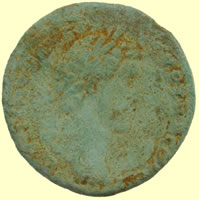 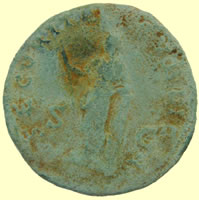 |
|||||||||||
Monster sized Roman bronze sent for ID 32.23mm dia , 22.59g, 4.25 mm thick Although the detail you speak of doesn't really come through too well in the photo, I'm pretty certain this is Antoninus Pius (138-161 AD) and the reverse appears to be Securitas - that's just about the only personification ever shown slouching at her ease, leaning against a short pillar like this. I believe the reverse type and legend is SECVRITAS PVBLICA - S - C. Securitas standing left holding long, transverse scepter, resting left elbow on column. This would date to 142 AD if I have the type right. Probably RIC III 641 (or similar) Mark
|
|||||||||||
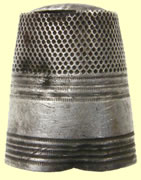 |
 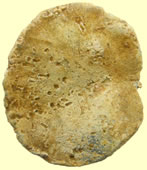 |
||||||||||
| Georgian silver thimble | Medieval lead token | ||||||||||
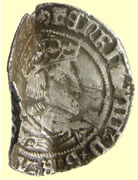  |
|||||||||||
| 1526-44 Henry VIII hammered silver groat - Rose mint mark | |||||||||||
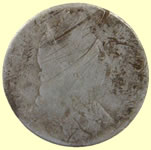  |
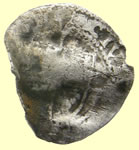 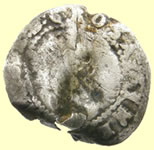 |
||||||||||
| 1696 William III milled silver sixpence | 1565 Elizabeth 1st hammered silver half groat | ||||||||||
 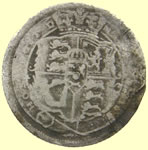 |
 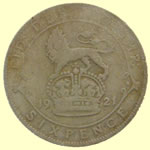 |
||||||||||
| 1816 George III milled silver sixpence | 1921 George V milled silver sixpence | ||||||||||
The seal legend reads 'Seal of Piro' 1260 AD Non Heraldic personal seal of freeholders of Charwelton Nothhamptonshire. 4 have been found attached to pasture rights. The design is typical of mid 13thC non heraldic seals, a fleur -de- lis, a flower, the lamb of god and each names it's owner on the legend
|
|||||||||||
Roman Eagles head bronze votive offering |
|||||||||||
  |
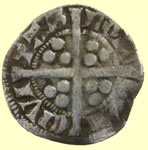  |
||||||||||
1351-61 Edward III hammered silver penny- Pre treaty - annulets in obv quadrants. Double annulet stops after TAS Obv EDWARDVS REX ANGLI Durham mint |
1341 Edward III hammered silver florin penny - Cross 3 Obv EDWAR ANGLE DNS HYB Rev CIVI/TAS/LON/DON London mint |
||||||||||
 |
 |
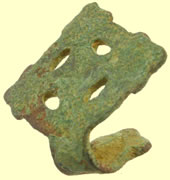 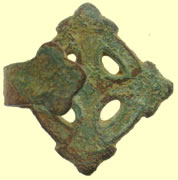 |
|||||||||
| WWII New Zealand army button | 19thC Royal artillery button | Medieval hanger | |||||||||
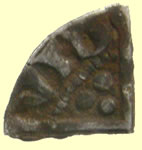 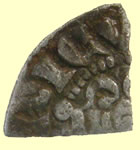 |
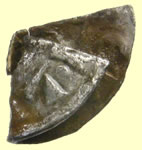  |
||||||||||
1247 Henry III hammered silver voided long cross 1/4 penny Moneyer David of London |
1215 Henry III hammered silver shortcross 1/2 penny | ||||||||||
  |
  |
||||||||||
| 1686 James II milled silver 2 pence | Very crisp 1616 James 1st hammered copper farthing - Lennox type 3 | ||||||||||
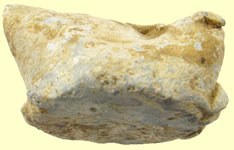 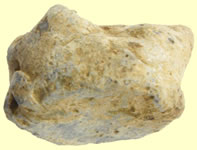 |
|||||||||||
| 1640's lead gunpowder measure and cap | |||||||||||
|
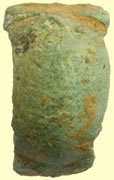 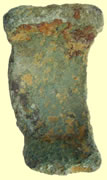 |
||||||||||
| Victorian decorated silver bezel - marked 925 silver | c8thC Saxon bow brooch | ||||||||||
As dug
'Cooked
|
|||||||||||
Roman silver coin - straight into 'cooker ' to remove crust Sent for ID In the wake of Nero's suicide, there was a period of civil war in which several serious contenders to the purple fought it out. The first to take control in the power vacuum was Galba. He might have done well if not overthrown by Otho - the fellow on this coin (and a former associate of Nero's - until Nero forced him to divorce his wife and give her to Nero who subsequently kicked her to death). Otho had hoped to be adopted as heir and successor by the much older Galba. When it became obvious this wasn't going to happen, Otho seized the throne on Jan 15, 69 and managed to hold on until the forces of Vitellius, defeating him soundly in a battle, made him decide to follow his former friend Nero in retiring from the Principiate by suicide, April 17, 69. In short (no pun intended) Otho reigned more briefly than any emperor before the late 3rd century. He never got around to ordering Imperial Æ small change to be struck with his portrait, concentrating his efforts on the gold and silver, consequently there is no Imperial Roman Æ for Otho. In Æ, only a very few Provincial issues exist for him. This is the basis of one of the classic frauds, the "Sestertius of Otho" produced for centuries to satisfy the collectors who wound up with an empty place in their sestertius tray http://www.stoa.org/gallery/Civil-War/22_Otho_sestertius Where a demand exists, someone will nearly aways endeavor to fill it. His gold and silver are both quite scarce, too. This denarius with the SECVRITAS P R reverse is the most common type for Otho, but this only means it's slightly less scarce than the other very scarce denarii. Mark |
|||||||||||
 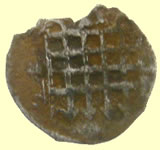 |
 |
||||||||||
| 1582-1600 Elizabeth 1st hammered silver half pence | Early 19thC 6th regiment of foot badge | ||||||||||
  |
|||||||||||
| C8thC Saxon brooch | |||||||||||
|
|||||||||||
| Post medieval silver ring 'GOD' reported as treasure to museum | |||||||||||
 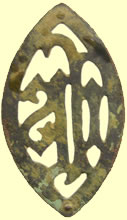 |
|||||||||||
15th/16thC religious pendant IHS: dating from the 8th c., this is an abbreviation for "IHESUS," the way Christ's Name was spelled in the Middle Ages (despite popular belief, the monogram stands neither for "Iesus Hominum Salvator" --"Jesus Saviour of Men" -- nor for "In His Service.") Popularized by St. Bernardine of Siena, the monogram was later used by St. Ignatius of Loyola as a symbol for the Jesuit Order. The IHS monogram is an abbreviation or shortening of Jesus' name in Greek to the first three letters. Thus ΙΗΣΟΥΣ, ιησυς (iēsus, "Jesus"), is shortened to ΙΗΣ (iota-eta-sigma), sometimes transliterated into Latin or English characters as IHS or ΙΗC. The symbol is said to appear rarely in the catacombs, only in the catacomb of Priscilla and the atrium of the Capella Gr�ca (Greek Chapel).1 It was popularized in the fifteenth century, however, by Franciscan disciple Bernadine of Sienna as a symbol of peace. In 1541 St. Ignatius Loyola adopted the symbol with three nails below and surrounded by the sun as the seal of the Jesuit order. Contrary to some authors, the monogram originally stood for neither for Iesus Hominum Salvator ("Jesus Savior of Men") nor for "In His Service." Some attribute its origin to Constantine's vision, where he saw a cross with the inscription "In hoc signo vinces" ("in this sign you shall conquer,"2 which is abbreviated, according to them, as IHS. However, this seems to require a stretch, as do claims that it is really a pagan symbol. The simplest explanation, as an abbreviation of Jesus' name, is best.
|
|||||||||||
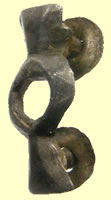  |
|||||||||||
| Medieval silver mount - reported as treasure to museum | |||||||||||
  |
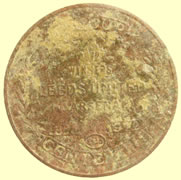 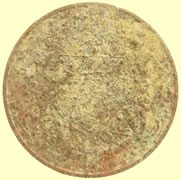 |
||||||||||
| 1694 William & Mary copper half penny | Leeds United FA cup winners medal | ||||||||||
 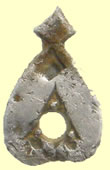 |
  |
||||||||||
| 17thC silvered mount | 1930 George V milled silver sixpence | ||||||||||
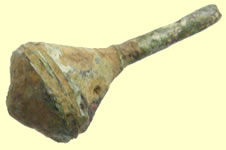  |
 |
 |
|||||||||
| Saxon silvered ridged pin head | Georgian buckle | Circa 1600 spur rowell | |||||||||
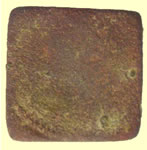 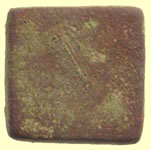 |
|
||||||||||
| 1603 James 1st coin weight | 18thC scabbard pommel - chariot and horse design | ||||||||||
 |
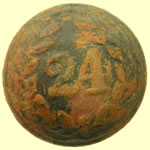 |
 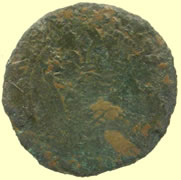 |
|||||||||
| 19thC livery button | Mid 19thC 24th Regiment of foot button The South Wales Borderers |
1340 AD French Jetton Crown introduced in 1340 by Philip VI (1328-50) Royal Crown with 3 rosettes across body of crown Rev Triple banded straight cross fleuretty AV |
|||||||||
 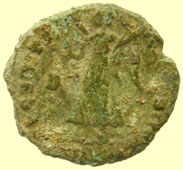 |
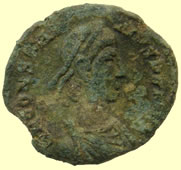 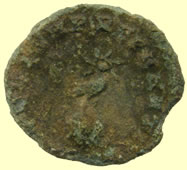 |
||||||||||
4thC Roman bronze coin sent for ID 17.2mm, 1.91g The first is a half-Majorina of Constantius II - it has the same FEL TEMP REPARATIO reverse as the far more common "fallen horseman" and "Emperor in galley" reverse types, but this shows a radiate phoenix standing on a globe. These were only struck for a relatively short time beginning in 348 (348 to 350, or thereabouts) because given the rapidly shrinking module of the Majorina (some call this denomination a Centenionalis, BTW, in case there's any confusion) as well as the inflation which caused it, they quickly ceased to make any sense. The exergual mitmark seems to be off-flan, so I can't say where it was minted, except that those on which the phoenix stands on a globe (as opposed to a rocky mound) were generally from the Western mints. |
4thC Roman bronze coin sent for ID 2.12g, 18.76mm The second is a "restored Centenionalis" (some call this piece a "Majorina" and the former type a "Centenionalis", so there is lots of room for confusion regarding the denomination-names here) most likely of either Valens or Valentinian I (364-378 / 364-375 respectively). This has the reverse type of Victory walking left carrying a wreath and palm-branch and the legend SECVRITAS REIPVBLICAE. This type was struck - alongside of the equally common GLORIA ROMANORVM reverse with emperor dragging a captive - throughout the 364-378 period by both of the brothers (Valens & Valentinian I) as well as for Gratian, a son of Valentinian I who was raised to Augustus by Valentinian in 367 and then took his place after he was killed at Hadrianopolis, and briefly for Valentinian II, a much younger (in order to protect the dynastic succession, he was raised to Augustus as an infant) half-brother of Gratian. Although the exergual mint mark is illegible in this photo, both of these very common "Æ3" types tended at most mints to employ a complex system of sequence or privy marks in the reverse fields in addition to the exergual mintmarks. Using a spreadsheet of right field/left field combinations to check the possible mints which used a D in the left reverse field (and nothing in the right field), we find this can only have come from the mints of Trier, Aquilea or Siscia. Those which were struck for Valentinian I (or brother Valens) can only have come from Aquilea or Siscia - so that narrows it down a bit. The obverse legend is very weak and fragmentary (as you can see) so if I was wrong about who's on the obverse and it is, in fact, Gratian, (although the first letter of the name looks more like a "V" than a "G" to me) then there is a possibility it's from Trier - in fact, for Gratian, it could only be Trier or Siscia. Since Valentinian II was only a child during almost his entire "reign" (regency) his portrait is always shown much smaller than the portrait on this piece - so he's not a possibility, making this determination slightly less complicated. Mark
|
||||||||||
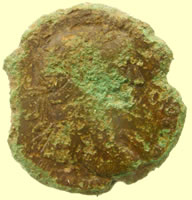  |
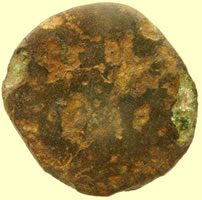  |
||||||||||
2ndC Roman bronze coin sent for ID 32.53mm, 18.34g Trajan 96-117 AD. - I'm reasonably sure it is Trajan, but it's pretty tough to be certain in this case. Mark
|
2ndC Roman bronze coin sent for ID 8.31g ,25.89mm The woman is Faustina Sr., wife of Antoninus Pius. Coins were struck in her honor both while she lived and in an extensive series of posthumous issues both by Antoninus and Marcus Aurelius. Her coins, therefore, date to a broad period - 138 until 175, when her daughter, Faustina Jr, wife of Marcus Aurelius, died and her posthmous coinage completely replaced her mother's. Mark
|
||||||||||
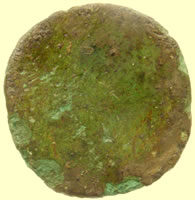  |
  |
||||||||||
2ndC Roman bronze coin sent for ID 17.93, 32.56 Hadrian - 117-138 AD. Unfortunately there isn't enough detail remaining to determine what reverse types of either of these may have been - which might allow us to date them more closely. Mark |
1844 Victoria milled silver four pence | ||||||||||
 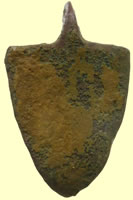 |
|||||||||||
| Medieval heraldic shield pendant - red and gold | |||||||||||
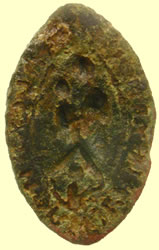  |
|||||||||||
| Medieval vessica seal matrix - Madonna and child - house of worship | |||||||||||
  |
  |
||||||||||
| 1327 Edward III hammered silver penny - quadrefoil at centre of reverse cross - York mint | 1578 Elizabeth 1st hammered silver half groat | ||||||||||
 |
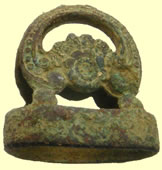 |
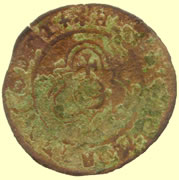  |
|||||||||
| Fire badge | Georgian fob seal mount | 1586 Hans Krauwincel II Rose orb Jeton HANNS KRAVWINCKEL IN NVRENB |
|||||||||
 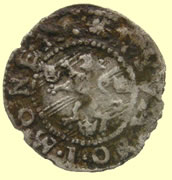 |
  |
||||||||||
1611 Swedish hammered silver 1 ore coin OBVERSE: Sheaf separating letters C.R. in circle and date 1611, legend: REGIS*SVECIA* |
1158-1180 AD Henry II Cross and Crosslet hammered silver penny - Tealby issue | ||||||||||
  |
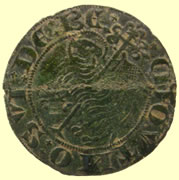 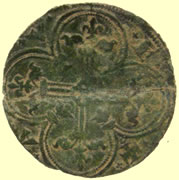 |
||||||||||
| 1854 Victoria milled silver 3 pence | 1285 - 1314 AD West Central France jeton The Paschal lamb jeton - ' I am the lamb of Berry' Obv MOVTON SVI:DE BE - Pascall lamb standing left, with one foot raised Rev Triple stranded cross fleuretty within 4 arched tressure |
||||||||||
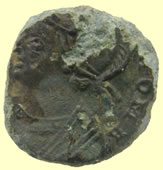  |
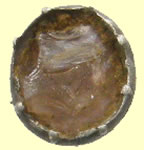 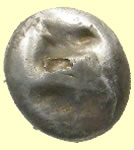 |
||||||||||
4thC Roman bronze coin sent for ID The city commemoratives - in honor of both Constantinople and Rome - are contemporaneous with the ubiquitous GLORIA EXERCITVS, 2 soldiers flanking 1 or 2 standards issues. Each has an allegorical representation of the city - as a relatively similar-looking helmeted and armored woman - facing left on the obverse - one has the legend, CONSTANTINOPOLIS, the other, VRBS ROMA. The Constantinople type had an anepigraphic reverse showing Victory, carrying spear and shield, in the prow of a galley. The Rome version has the anepigraphic Shewolf & Twins reverse. These two types were introduced in 330 AD to announce/commemorate Constantine the Great's re-founding of the city of Byzantium as Constantiople, his new Imperial capital. Both types were struck until his death in 337, and the obverses were resurrected with single-standard Gloria Ex reverses at a number of eastern mints in the late 330's and early 340's. Mark |
18thC silver button | ||||||||||
 |
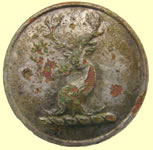 |
 |
|||||||||
| Royal artillery badge | 19thC livery button | 17thC sword hanger | |||||||||
  |
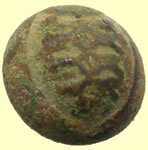 |
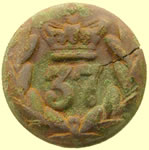 |
|||||||||
| Interesting lead coin weight - no looked it up in ref books yet | 18thc Royal artillery button | 37th (North Hampshire) O/R's - 1855-1881 |
|||||||||
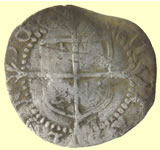  |
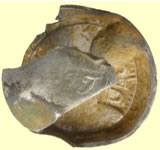 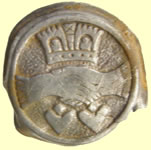 |
||||||||||
| 1592-5 Elizabeth 1st hammered silver penny | 17thC Charles II silver button - reported as treasure | ||||||||||
  |
  |
||||||||||
| 1924 George V milled silver sixpence | 1912 George V milled silver sixpence | ||||||||||
  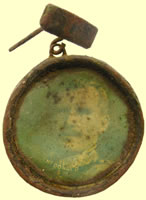 |
|||||||||||
| Victorian brooch - male in military uniform signed Mc Donald | |||||||||||
 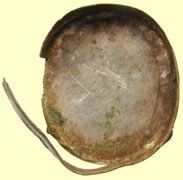 |
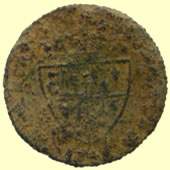 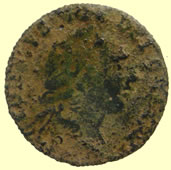 |
||||||||||
| Georgian silver locket | George III gold half guinea gaming token | ||||||||||
 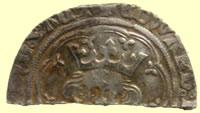 |
|||||||||||
1327 Edward III hammered silver groat Rev CIVI/TAS/LON/DON - London mint |
|||||||||||
 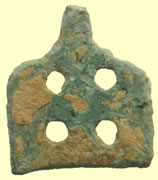 |
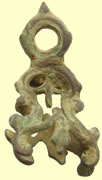 |
||||||||||
| Saxon mount | Georgian fob seal mount | ||||||||||
  |
|||||||||||
| C8thC Viking fretwork 'ladder of life' strapend - blue and green enamel remains | |||||||||||
 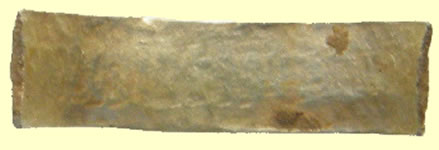 |
|||||||||||
Early medieval gold ring fragment - reported as treasure to museum 20.79mm x 1.14g |
|||||||||||
 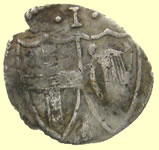 |
 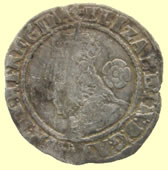 |
||||||||||
| 1649 Commonwealth hammered silver penny | 1578 Elizabeth 1st hammered silver three pence | ||||||||||
 |
|||||||||||



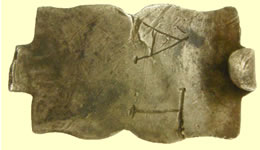


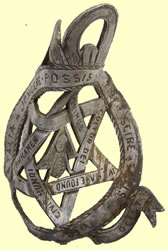

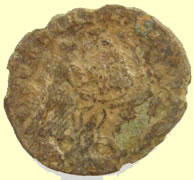
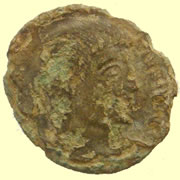
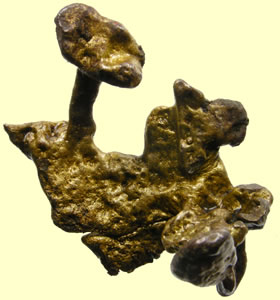
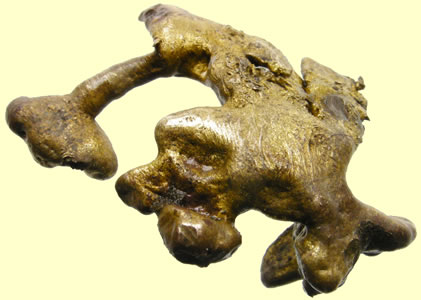



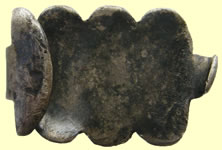


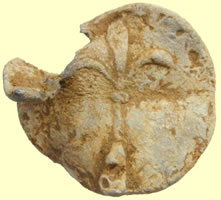

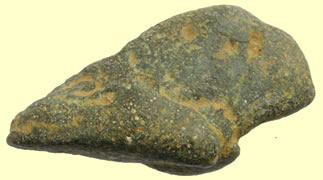
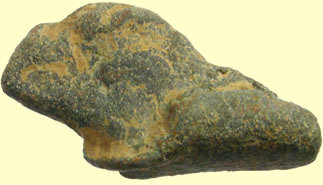
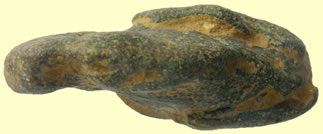
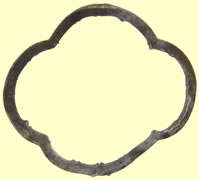
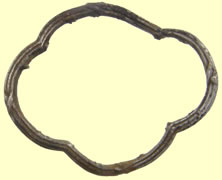

 '
'
